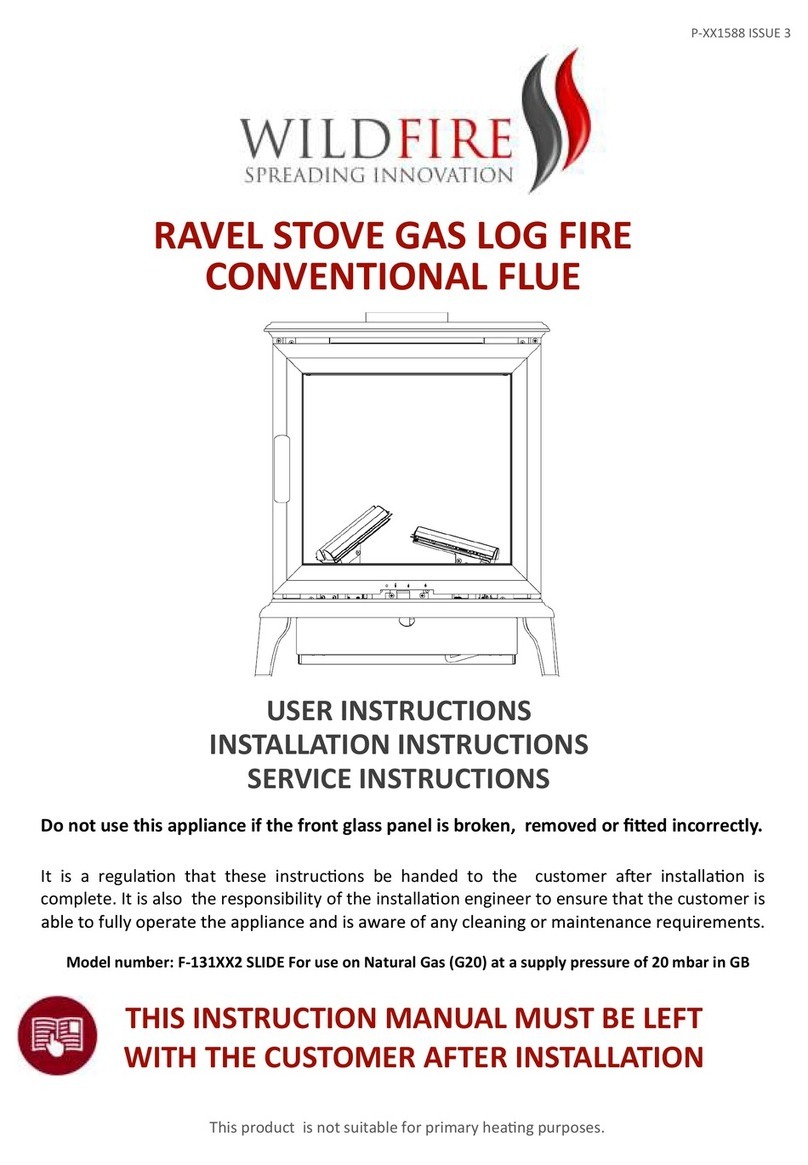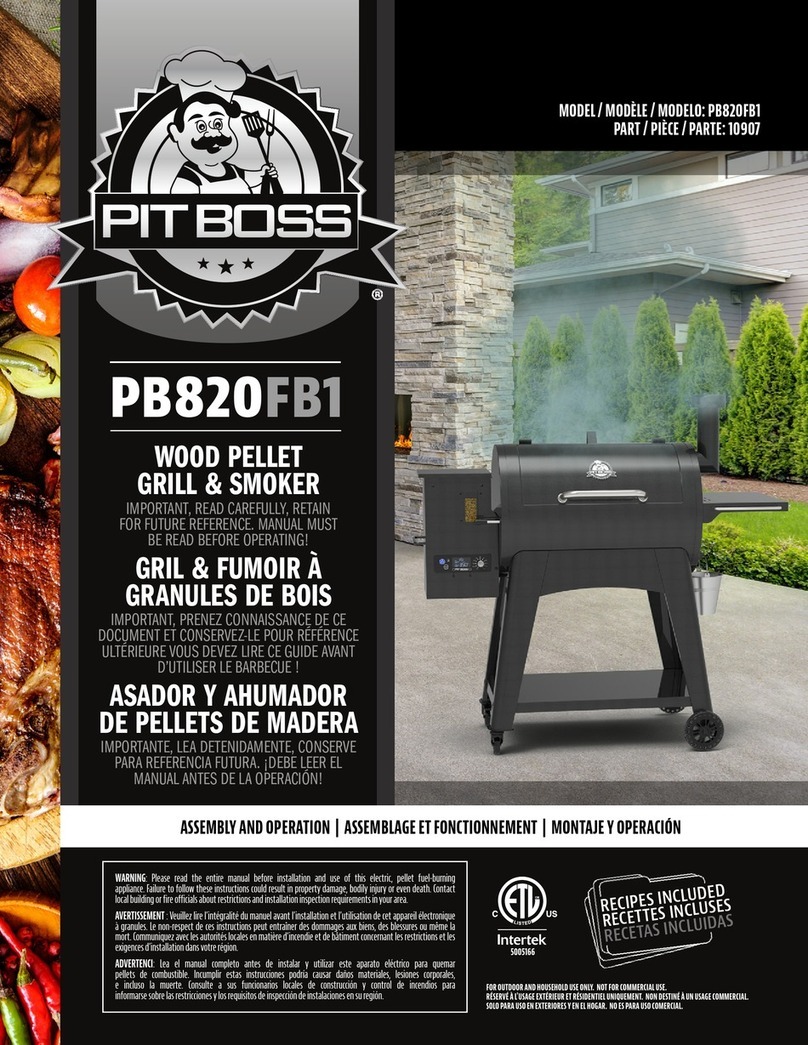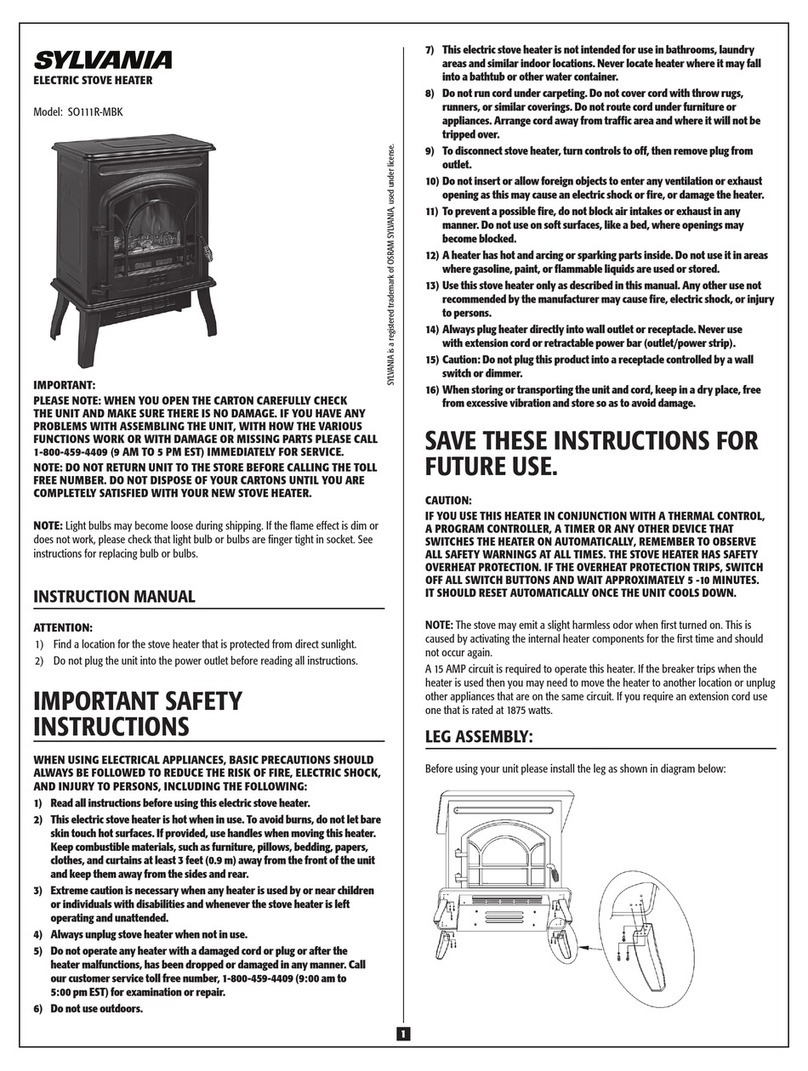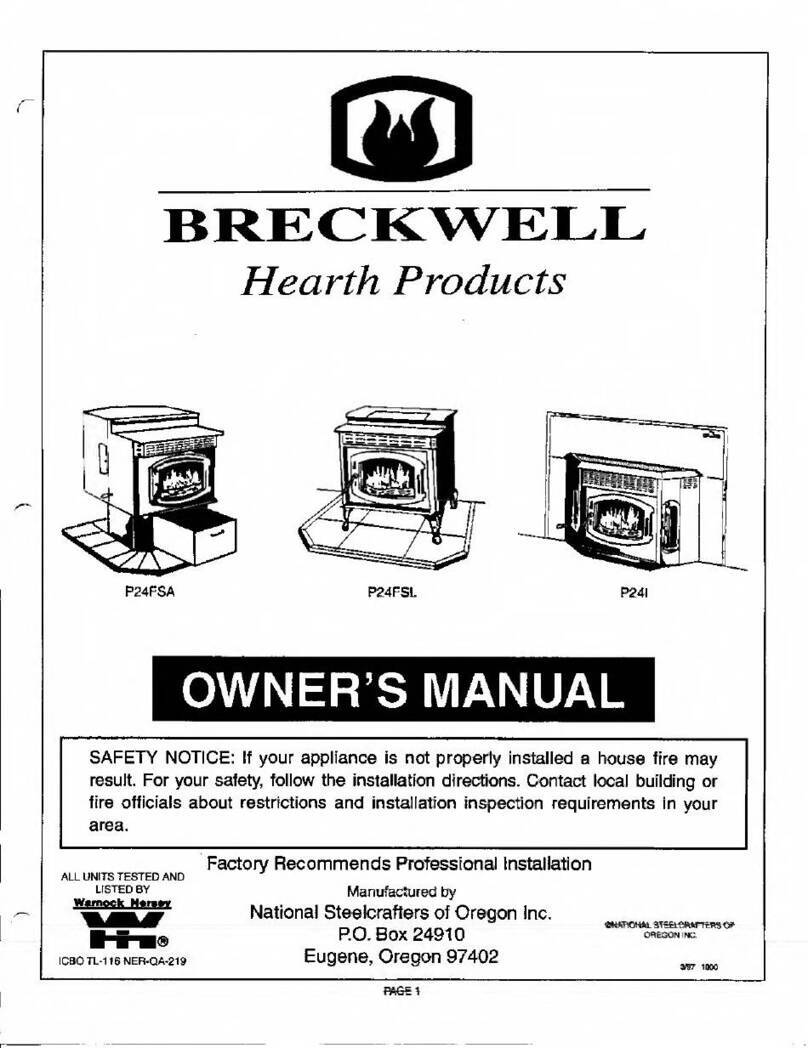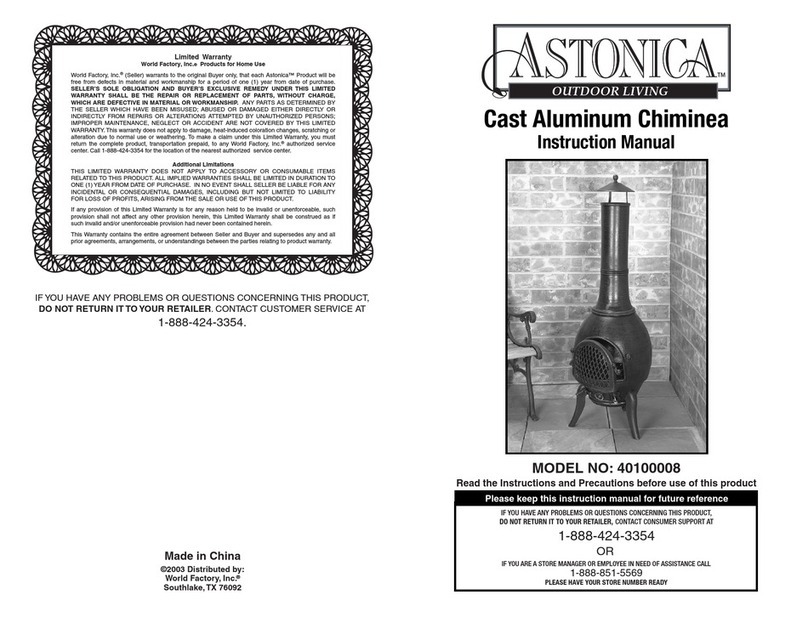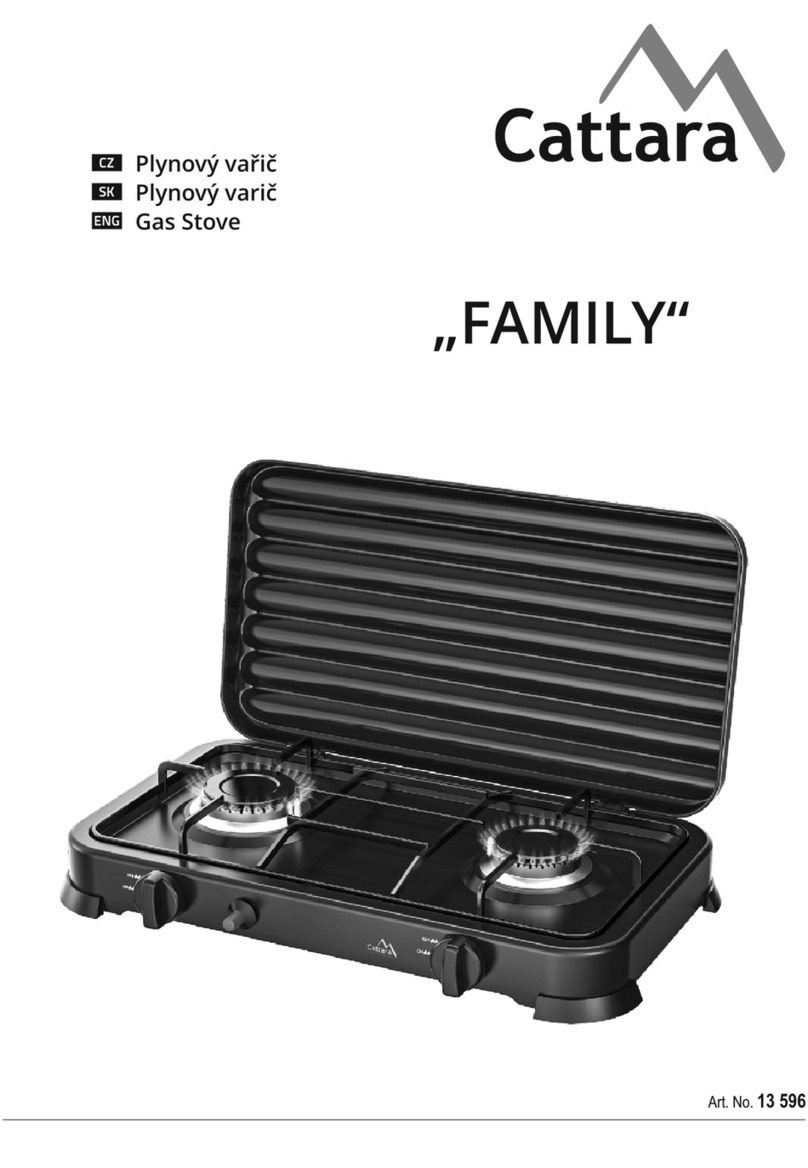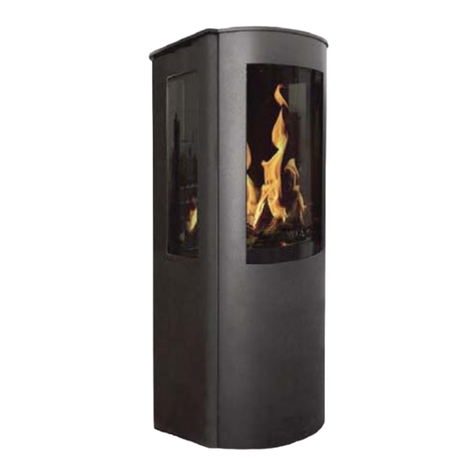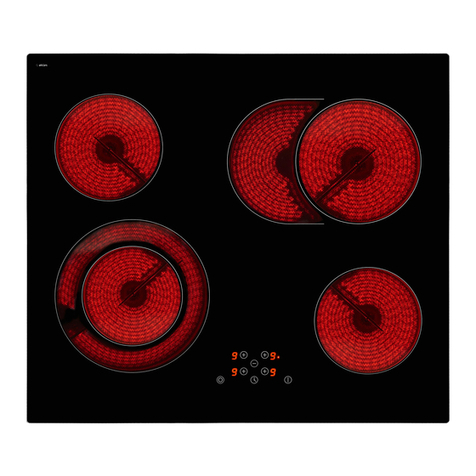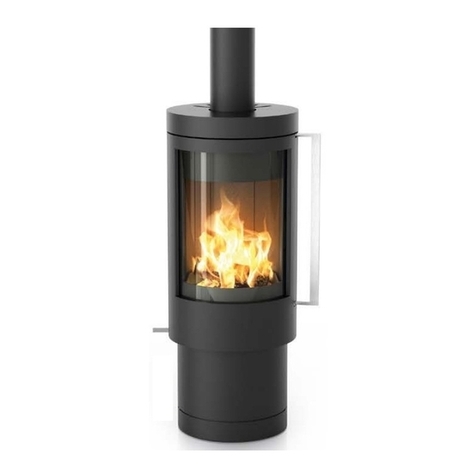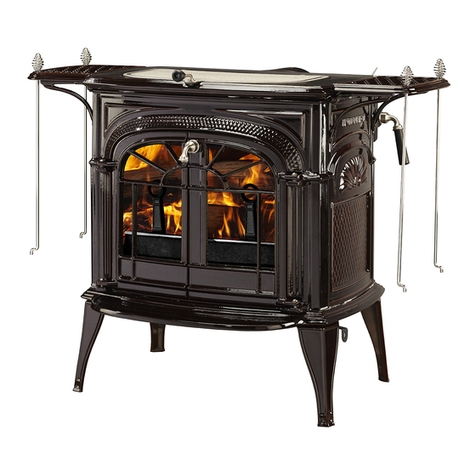
DE_SCC_2_0_7
Hinweise zur pfl ege und sicheren verwendung
SICHERHEITSINFORMATIONEN
WARNUNG:
• Die Vorrichtung nicht mit Brennstoff (unbehandeltem Holz oder Holzscheiten) überladen; durch ein zu starkes Feuer kann
die Vorrichtung beschädigt werden. Der Brennstoff darf niemals aus der Öff nung der Vorrichtung herausragen.
• Diese Vorrichtung wird sehr heiß und darf während des Gebrauchs nicht bewegt werden.
• Beim Nachfüllen von Brennstoff oder bei der Verwendung eines Sicherheitswerkzeugs (falls mitgeliefert) stets
hitzebeständige Handschuhe tragen.
• Die Vorrichtung nicht in einem engen und/oder bewohnbaren Raum, z.B. in Häusern, Zelten, Wohnwagen, Wohnmobilen
oder Booten verwenden, da die Gefahr einer Kohlenmonoxidvergiftung mit Todesfolge besteht.
• Kinder und Haustiere müssen von der Vorrichtung ferngehalten werden.
• Diese Vorrichtung darf nicht als Brennofen verwendet werden.
BRANDGEFAHR:
• Diese Vorrichtung muss vor der Verwendung auf einer ebenen, sicheren Grundlage aufgestellt werden.
• Diese Vorrichtung darf nicht auf Holzböden oder anderen brennbaren Oberfl ächen wie trockenem Gras, Holzspänen,
Blättern oder dekorativer Rinde usw. verwendet werden.
• Diese Vorrichtung darf nicht auf Kunstrasen oder anderen nicht hitzebeständigen Oberfl ächen verwendet werden.
• Während des Gebrauchs kann heiße Glut austreten.
• Diese Vorrichtung muss mindestens 2 Meter von entfl ammbaren Materialien entfernt aufgestellt werden und einen
Mindestabstand von 2 Metern im Oberbereich und der angrenzenden Umgebung haben.
PFLEGE UND VERWENDUNG
• Die Vorrichtung beim Heben oder Bewegen niemals ziehen oder schleifen; gegebenenfalls Hilfe in Anspruch nehmen.
• Da diese Vorrichtung Bauteile aus Stahl und/oder Gusseisen hat, altert die Oberfl äche und entwickelt mit der Zeit
Oberfl ächenrost, wenn sie natürlichen Witterungseinfl üssen ausgesetzt wird. Dies ist zu erwarten und stellt keinen Fehler
dar.
• Das Feuer nie so stark entfachen, dass die Flammen den Rauchabzug erreichen.
• Diese Vorrichtung darf niemals mit angebrachtem Deckel (falls mitgeliefert) benutzt werden.
• Aus Sicherheitsgründen wird empfohlen, diese Vorrichtung vor jedem Gebrauch auf Anzeichen von Materialermüdung und
Beschädigung zu überprüfen. Wenn die Vorrichtung das Ende ihrer natürlichen Lebensdauer erreicht hat, muss sie ersetzt
werden.
• Wenn diese Vorrichtung im Freien gelassen wird, muss eine geeignete Abdeckung verwendet werden, nachdem es
vollständig abgekühlt ist.
• Diese Vorrichtung kann Spuren oder Flecken auf der Terrasse hinterlassen. Zum Schutz des Bodens sollte die Vorrichtung
auf eine separate Terrassenplatte oder einen Ziegelsteinsockel gestellt werden.
• Der Kochgrill sollte mit einer Lösung aus Spülmittel und warmem Wasser gereinigt werden. Er ist nicht für die Reinigung in
der Geschirrspülmaschine geeignet.
FESTBRENNSTOFFARTEN UND -MENGEN
• Zum Heizen im Freien können mit dieser Vorrichtung die folgenden Brennstoff arten verwendet werden: unbehandeltes
Holz, Holzscheite und Easylogs.
• Zum Kochen von Lebensmitteln ist die Verwendung von Grill-Holzkohle erforderlich.
• In dieser Vorrichtung darf keine Kohle verbrannt werden.
• Nicht mit Brennstoff überladen: Es wird empfohlen, die Feuerschale bzw. den Verbrennungsbereich nur bis zur Hälfte
seines Fassungsvermögens zu füllen.
• Die empfohlene Brennstoff menge darf nie um mehr als 50% überschritten werden.
ANZÜNDEN, BRENNSTOFF HINZUFÜGEN, LÖSCHEN
• WARNUNG! Niemals Spiritus oder Benzin zum Anzünden oder zum erneuten Anzünden verwenden. Nur Feueranzünder
verwenden, der der EN 1860-3 entspricht.
• Einen Stapel locker zerknüllter Zeitungen vorbereiten und in die Brennkammer legen.
• Fein gespaltenes, trockenes Brennholz auf das Papier legen.
• Die Hälfte des Brennstoff s hinzufügen und genug Platz lassen, um das Paper anzuzünden.
• Zum Anzünden des Papiers lange Sicherheitsstreichhölzer oder ein Feuerzeug mit großer Reichweite verwenden.
• Sobald das Feuer entstanden ist, den restlichen Brennstoff hinzufügen.
• Beim Hinzufügen von Brennstoff immer hitzebeständige Handschuhe tragen.
• Den Brennstoff nicht in die Vorrichtung fallenlassen oder werfen, da dies zu Schäden führen kann.
• Um das Feuer nach dem Gebrauch zu löschen: keinen Brennstoff mehr hinzufügen und das Feuer abklingen lassen; das
Feuer kann auch mit Sand gelöscht werden. Kein Wasser verwenden, da dies die Vorrichtung beschädigen und
überschüssige Aschepartikel erzeugen kann.
ZUBEREITUNG VON LEBENSMITTELN
• VORSICHT: Der Verzehr von rohem oder nicht ausreichend gegartem Fleisch kann zu einer Lebensmittelvergiftung
führen.
• Vor dem Kochen sollte die Vorrichtung aufgeheizt werden und der Brennstoff 30 Minuten lang rot glühen, bevor zum
ersten Mal gekocht wird.
• Der Brennstoff muss eine Ascheschicht entwickelt haben, bevor mit dem Kochen begonnen werden kann.
• Vor und nach dem Umgang mit rohem Fleisch und vor dem Essen immer die Hände waschen.
• Rohes Fleisch von gekochtem Fleisch und anderen Lebensmitteln fernhalten.
• Für die Handhabung von gekochten und ungekochten Lebensmitteln nicht die gleichen Utensilien verwenden.
• Fleisch muss vor dem Verzehr gründlich gekocht werden.
DE
FR_SCC_2_0_7
Consignes pour une utilisation et un entretien en toute sécurité de l’appareil
INFORMATIONS DE SÉCURITÉ
AVERTISSEMENT:
• Ne surchargez pas l’appareil en combustible (bois non traité ou bûche) ; si le feu est trop intense, cela pourrait
l’endommager. Aucun combustible ne doit jamais dépasser de la bouche de l’appareil.
• Ne déplacez pas cet appareil en cours de fonctionnement, car il devient très chaud.
• Utilisez toujours des gants résistants à la chaleur quand vous ajoutez du combustible ou que vous utilisez des
outils de sécurité (lorsqu’ils sont fournis).
• N’utilisez pas cet appareil dans un espace confi né et/ou habitable, comme une maison, une tente, une caravane,
un camping-car ou un bateau. Risque d’empoisonnement mortel au dioxyde de carbone.
• Tenez les enfants et les animaux de compagnie à l’écart.
• N’utilisez pas cet appareil comme un four.
RISQUE D’INCENDIE:
• Cet appareil doit être installé sur une surface plane et sûre avant utilisation.
• N’utilisez pas cet appareil sur une terrasse en bois ou toute autre surface infl ammable, comme de l’herbe sèche,
des copeaux de bois, des feuilles ou des écorces décoratives.
• N’utilisez pas cet appareil sur de l’herbe artifi cielle ou d’autres surfaces qui ne sont pas résistantes à la chaleur.
• Des braises chaudes peuvent être projetées en cours d’utilisation.
• Veillez à ce que cet appareil soit positionné à au moins 2 mètres de tout matériau infl ammable et à laisser un
espace minimum de 2 mètres au-dessus et autour de l’appareil.
ENTRETIEN ET UTILISATION
• Ne traînez jamais l’appareil lorsque vous voulez le soulever ou le déplacer. Demandez de l’aide à quelqu’un si
nécessaire.
• Comme cet appareil contient des composants à base d’acier et/ou de fonte, sa surface va vieillir et de la rouille
va s’y former avec le temps, une fois qu’elle sera exposée aux éléments naturels. Ce phénomène est prévisible
et ne constitue pas une défaillance de l’appareil.
• N’alimentez jamais le feu au point que les fl ammes atteignent le conduit de cet appareil.
• Cet appareil ne doit jamais être utilisé avec son couvercle posé (si fourni).
• Pour des raisons de sécurité, il est recommandé de procéder à une inspection de cet appareil avant chaque
utilisation, pour vérifi er qu’il n’y ait pas de signe d’usure ou de dégradation. Veillez à remplacer tout appareil
étant arrivé à la fi n de son cycle de vie naturel.
• Si cet appareil est laissé en extérieur, une couverture adéquate doit être utilisée pour le protéger, une fois qu’il a
complètement refroidi.
• Cet appareil peut provoquer des tâches dans un patio. Pour éviter cela, placez-le sur une dalle ou un support en
brique séparé.
• La grille de cuisson doit être lavée avec une solution de nettoyage liquide mélangée à de l’eau chaude. Un
nettoyage au lave-vaisselle n’est pas adapté.
TYPES ET QUANTITÉS DE COMBUSTIBLES SOLIDES
• Pour un chauff age en extérieur, les types de combustibles suivants peuvent être utilisés avec cet appareil : bois
non traité, bûches et bûchettes Easylog.
• Pour cuisiner, il est essentiel d’utiliser du charbon de bois.
• Ne brûlez pas de charbon dans cet appareil.
• Ne surchargez pas l’appareil de combustible : il est recommandé de le remplir uniquement à la moitié de la
capacité du foyer ou de la zone de combustion du combustible.
• La quantité de combustible recommandée ne doit jamais être dépassée de plus de 50 %.
ALLUMER, ALIMENTER ET ÉTEINDRE
• ATTENTION ! N’utilisez pas de l’alcool ou de l’essence pour allumer ou raviver un feu. Utilisez uniquement des
dispositifs anti-incendie conformes à la norme EN 1860-3.
• Préparez un tas de papier journal froissé et placez-le dans le compartiment à feu.
• Empilez du bois de chauff age sec et fi nement coupé au-dessus du papier.
• Ajoutez la moitié du combustible, en laissant un accès pour enfl ammer le papier.
• Pour enfl ammer le papier, utilisez une longue allumette de sûreté ou un briquet longue tige.
• Une fois que le feu est stable, ajoutez le combustible restant.
• Utilisez systématiquement des gants résistants à la chaleur lorsque vous ajoutez du combustible.
• Ne jetez pas de combustible dans l’appareil au risque de le fi ssurer.
• Pour éteindre le feu après utilisation : n’ajoutez plus de combustible et laissez mourir le feu, ou alors,
étouff ez-le avec du sable. N’utilisez pas de l’eau. Vous risqueriez d’endommager l’appareil et de créer un excès
de particules de cendre.
CUISSON DES ALIMENTS
• ATTENTION : consommer de la viande crue ou insuffi samment cuite peut entraîner un empoisonnement
alimentaire.
• Il est recommandé de chauff er l’appareil et de maintenir le combustible rouge ardent pendant 30 minutes avant
de cuire des aliments pour la première fois.
• Ne cuisez pas les aliments tant que le combustible n’est pas recouvert d’une couche de cendre.
• Lavez-vous systématiquement les mains avant et après avoir manipulé de la viande crue et avant de manger.
• Conservez la viande crue à l’écart de la viande cuite et des autres aliments.
• N’utilisez pas les mêmes ustensiles pour manipuler les viandes cuites et crues.
• Assurez-vous que toute la viande est bien cuite avant de la manger.
FR

